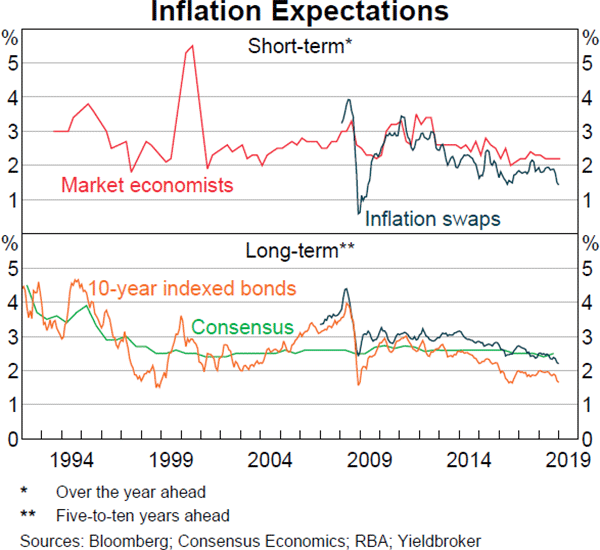Statement on Monetary Policy – February 2019 4. Inflation
Inflation remains low
Underlying inflation was a little under ½ per cent in the December quarter and 1¾ per cent over the year (Table 4.1; Graph 4.1). This was slightly lower than the forecast in the November Statement on Monetary Policy. The inflation outcomes in the December quarter did not materially change the Bank's assessment of underlying inflation pressures in the economy. Headline inflation was 0.4 per cent (seasonally adjusted) in the December quarter and 1.8 per cent over the year (Graph 4.2). This was also lower than the forecast in the November Statement, largely due to a decline in fuel prices in the quarter.
Year-ended underlying inflation is above its trough and has been around 1¾ per cent for some time. The tightening of the labour market over this period and associated gradual pick-up in wages growth has provided a little bit of upward pressure on inflation. There has been some upward momentum in inflation in those parts of the CPI basket that have historically been sensitive to changes in the unemployment rate. More recently, deflation in the prices of tradable items (excluding volatile items) has eased, consistent with some pass-through from the exchange rate depreciation over the past year (Graph 4.3). In contrast, administered price inflation, including utilities, and new dwelling cost inflation have declined (Graph 4.4). Over the past year, the share of items for which inflation has increased has been similar to the share of items for which inflation has declined.
| Quarterly(a) | Year-ended(b) | |||
|---|---|---|---|---|
| December quarter 2018 | September quarter 2018 | December quarter 2018 | September quarter 2018 | |
| Consumer Price Index | 0.5 | 0.4 | 1.8 | 1.9 |
| Seasonally adjusted CPI | 0.4 | 0.2 | – | – |
| – Tradables | −0.1 | 0.2 | 0.6 | 1.4 |
| – Tradables (excl volatile items)(c) | 0.2 | 0.0 | −0.1 | −0.8 |
| – Non-tradables | 0.8 | 0.2 | 2.4 | 2.2 |
| Underlying Measures | ||||
| Trimmed mean | 0.4 | 0.4 | 1.8 | 1.8 |
| Weighted median | 0.4 | 0.4 | 1.7 | 1.8 |
| CPI excl volatile items(c) | 0.6 | 0.1 | 1.6 | 1.2 |
|
(a) Except for the headline CPI, quarterly changes are based on
seasonally adjusted data; those not published by the ABS are calculated
by the RBA using seasonal factors published by the ABS Sources: ABS; RBA |
||||
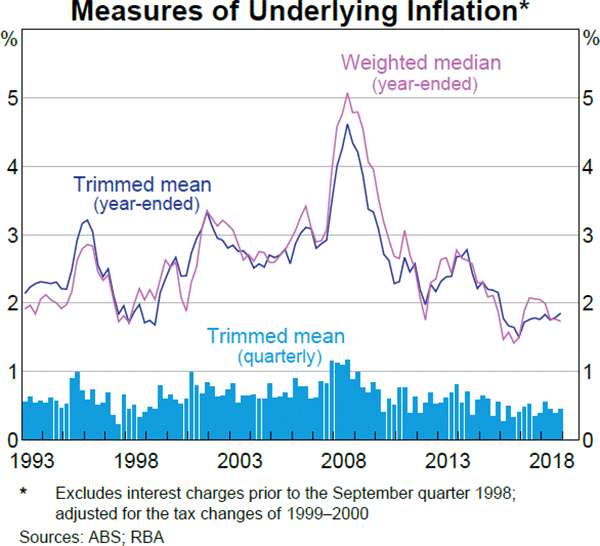
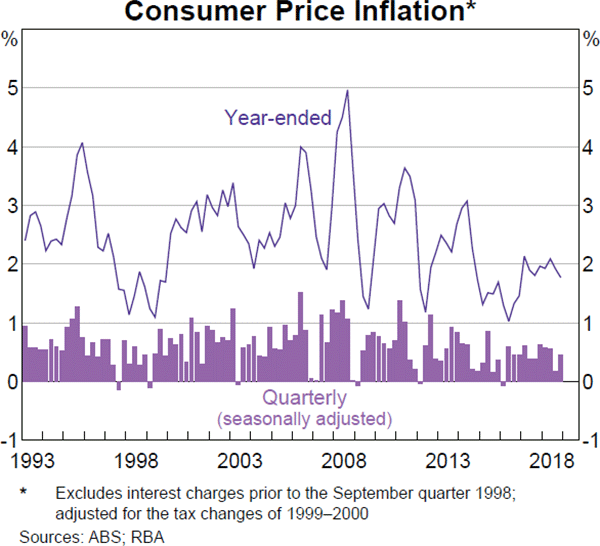
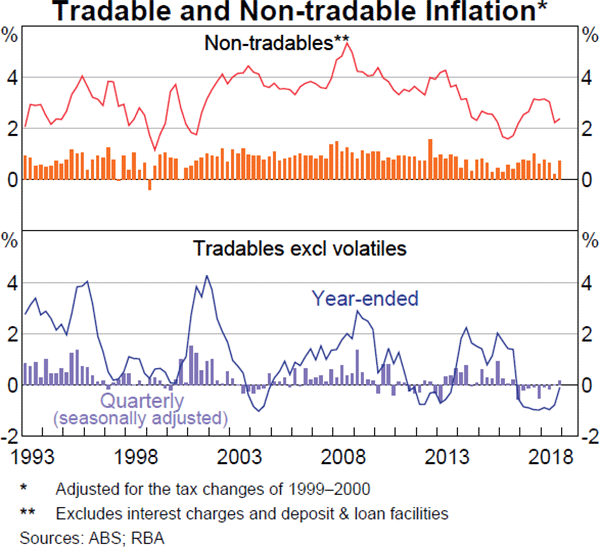
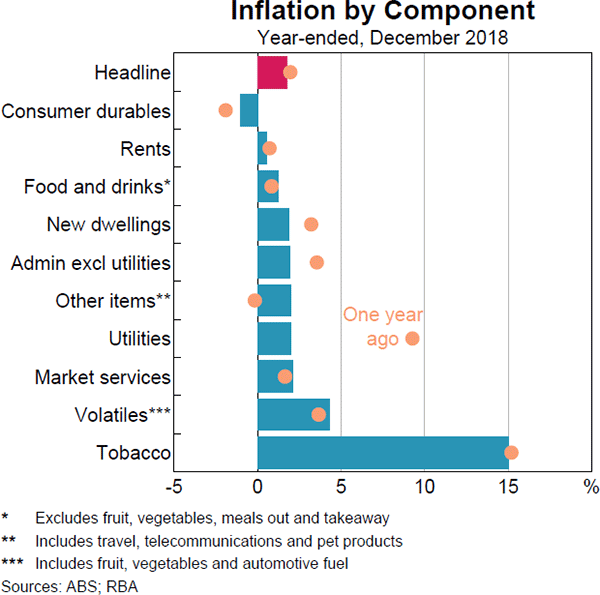
Domestic price pressures remain subdued
Inflation in the prices of market services, which include hairdressing, financial services and meals out & takeaway, has increased a little from a year ago but remains low (Graph 4.5). The prices of these services are generally driven by domestic factors such as labour costs and commercial rents, which have also increased relatively slowly over recent years.
Rent inflation was 0.5 per cent over the year, which is around its lowest rate since mid 1993 (Graph 4.6). Rent growth continues to differ considerably across capital cities. Rents are 6 per cent lower over the year in Perth, and have been falling since 2015. However, the pace of these falls has eased since mid 2017 as the Perth vacancy rate has declined. Rent inflation has declined a little in Sydney, reflecting an increase in the vacancy rate to above-average levels and falls in newly advertised rents. In contrast, Hobart rents are growing at around 5 per cent in year-ended terms.
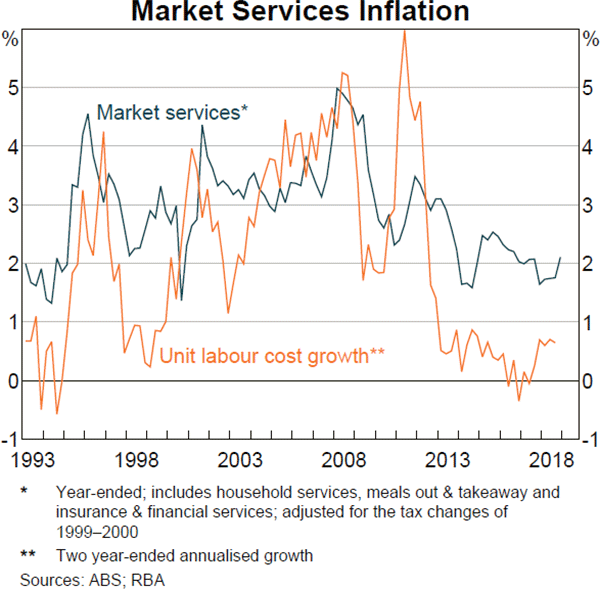
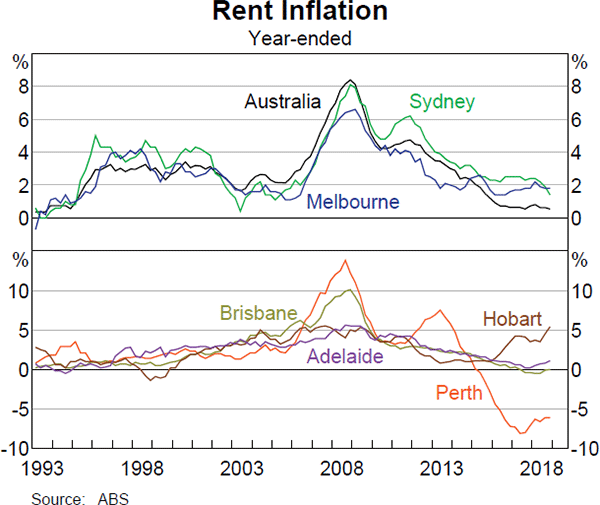
New dwelling inflation remains subdued despite high levels of dwelling investment over recent years. The cost of building a new dwelling increased by 1.8 per cent over the year to December, well below its long-run average (Graph 4.7). Over the year, the increases in the cost of new dwelling construction in Sydney and Melbourne were relatively large. This is consistent with reports that competition from infrastructure and commercial projects has contributed to higher material prices and wage pressures in the eastern states.
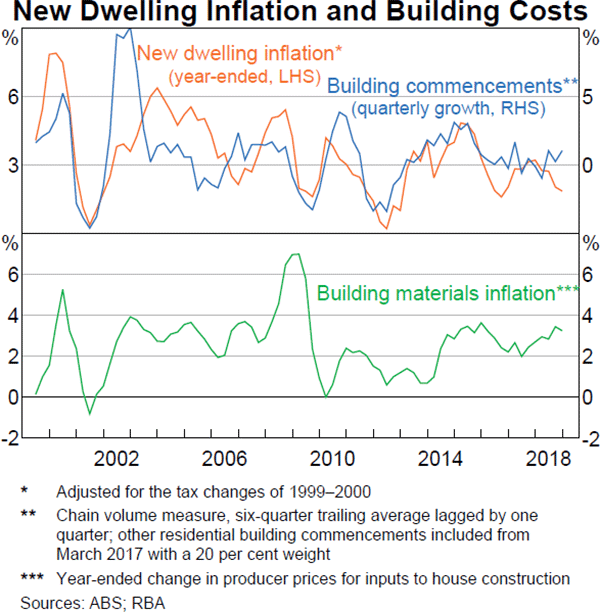
Administered price inflation has slowed
Inflation in the price of administered items has slowed considerably over the past year to 1.9 per cent (Graph 4.8). Administered items are those for which prices are (at least partly) regulated or those which are mainly provided by the public sector. The recent decline in inflation for these items reflects several pricing decisions, including lower-than-average property rates and health insurance premium increases, the introduction of the new child care subsidy payment, and the pass-through of lower wholesale energy prices to retail electricity prices (Graph 4.9). In the December quarter itself, administered prices were little changed in non-seasonally adjusted terms, since few administered price changes occur at the end of the calendar year. Several administered price changes occur in the March quarter, including the annual adjustment to standing offer electricity prices in Victoria.
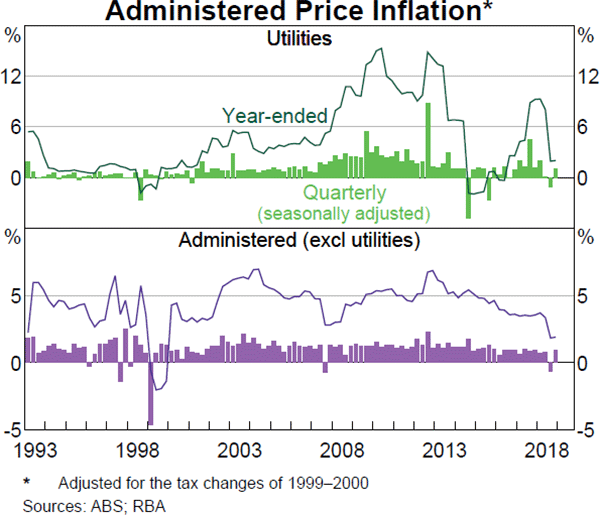
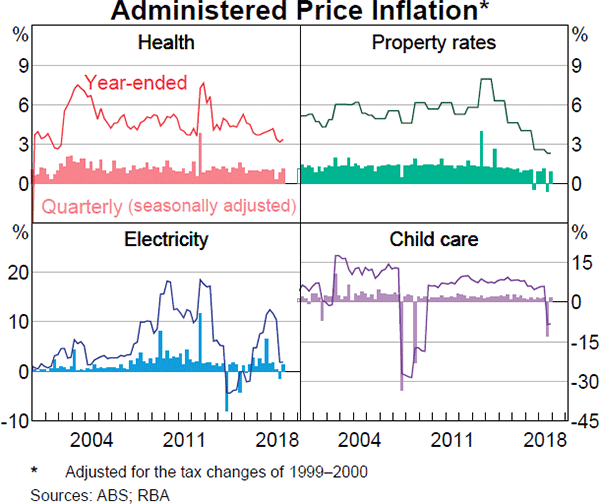
Higher import prices have put upward pressure on retail prices
Retail prices rose a little in the December quarter, to be unchanged over the year. This follows a number of years of retail price deflation and is consistent with the depreciation of the exchange rate (Graph 4.10). Nonetheless, retail inflation remains low, suggesting ongoing competitive pressures in the industry. The pick-up in retail inflation in the December quarter has been broad based across both food and consumer durable items. Furniture & furnishings and household appliances & utensils prices increased in the December quarter, after falling for several years. The drought in eastern Australia is one factor that has contributed to higher food prices. Inflation in dairy products increased in the December quarter following the imposition of a drought-related levy on certain milk products in some supermarkets (Graph 4.11). Meat inflation also increased strongly, because of both the drought and strong international demand for Australian meat.
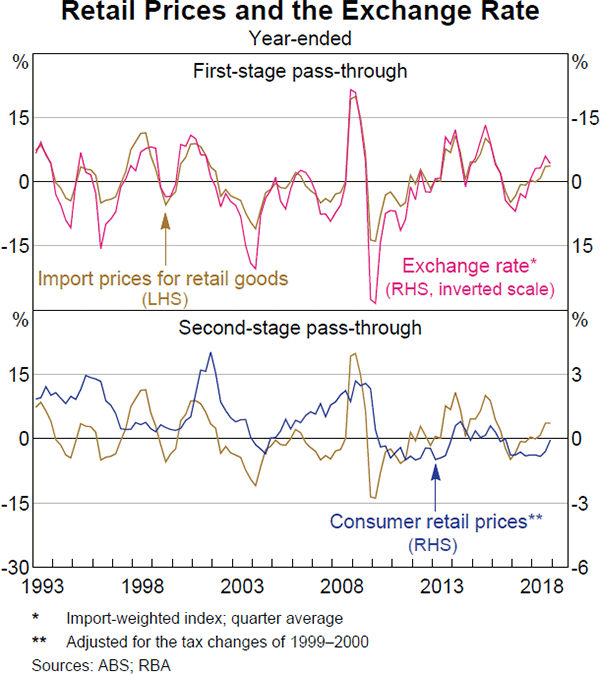
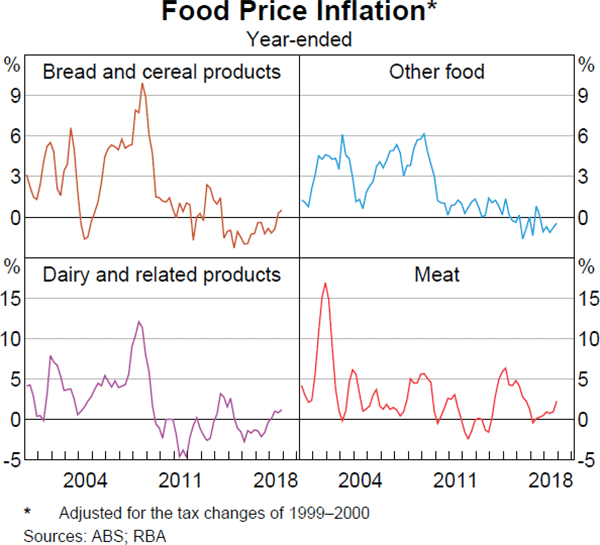
Growth in the retail industry's input costs has been subdued (Graph 4.12). Retail rents have been little changed for some time, while growth in retail labour costs has been low. Wholesale electricity prices are little changed over the past year, though the level of electricity prices is much higher than a couple of years ago.
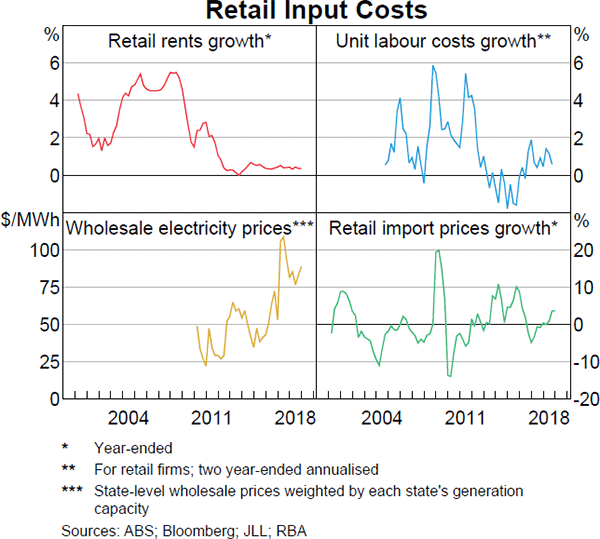
Wages growth has picked up, but remains low
Growth in the Wage Price Index (WPI) increased to 0.6 per cent in the September quarter, to be 2.3 per cent higher over the year (Graph 4.13). The increase in wages growth over the year is more pronounced when bonuses and commissions are included. Year-ended wages growth is higher than it was a year ago in most industries. It remains strongest in the health care & social assistance and education industries, and lowest in the retail and mining industries (Graph 4.14). The modest increase in wages growth since 2016 is consistent with the gradual tightening of the labour market over that period.
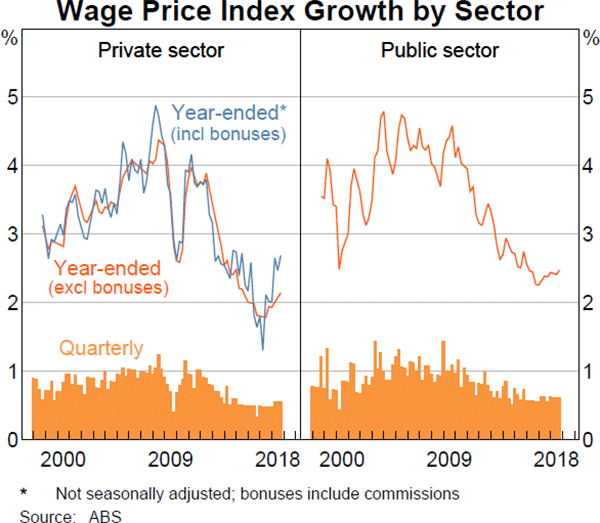
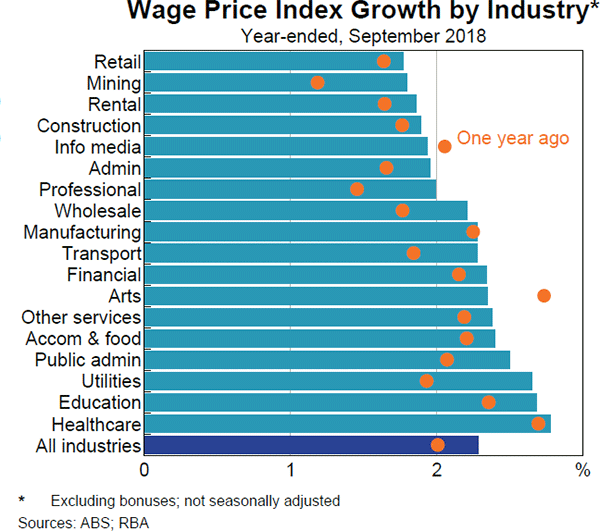
Wages growth in the quarter was also boosted by the 3.5 per cent increase in the award and minimum wages on 1 July. As at May 2018, a little over 20 per cent of employees had their pay set by awards, which are mostly determined by the Fair Work Commission (FWC). The FWC award decision is also likely to influence wage outcomes for some employees not on an award. For example, data from the Department of Jobs and Small Business suggest that nearly 20 per cent of employees on existing federal enterprise bargaining agreements have their wage outcomes linked in some way to FWC decisions.
Analysis of the micro-level WPI data from the Australian Bureau of Statistics suggests that the small pick-up in wages growth since 2016 stems from a higher share of jobs experiencing a change in wages in any given quarter, rather than an increase in the average size of the changes (Graph 4.15). This is largely because wage ‘freezes’ have become less common. The decline in the share of jobs with wage freezes has been fairly broad based across both the public and private sectors, and among those groups whose pay is set by enterprise bargaining agreements (EBAs) and individual agreements. For example, a number of large retail EBAs have recently been finalised after a lengthy delay in negotiations that had resulted in pay freezes. Analysis using the micro-level data suggests jobs that had experienced a wage freeze tend to get larger wage increases than jobs that had not had a wage freeze. However, the share of workers experiencing wage freezes remains elevated (relative to a longer-run average) in some industries.
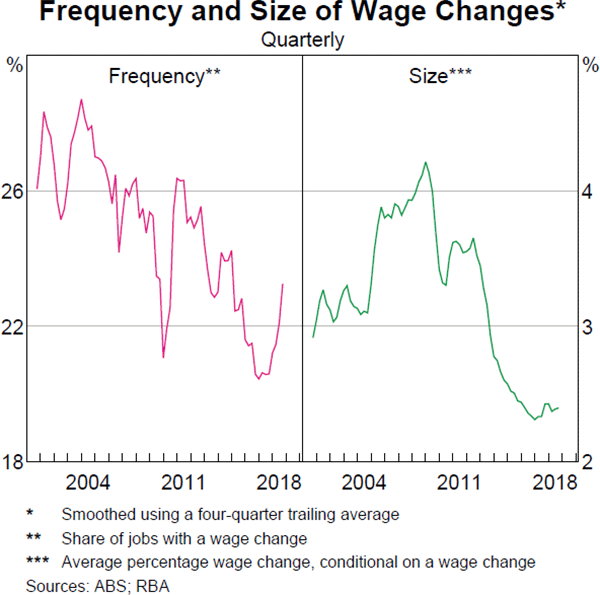
Growth in the national accounts measure of average earnings per hour (AENA) has risen a little over the past year, but remains subdued. AENA captures a broader range of labour costs than the WPI, and is affected by compositional changes in employment. One of these compositional changes may be related to a decline in voluntary turnover; around 10 per cent of employed persons changed jobs voluntarily in each of the last five years, down from around 13 per cent per year during the strong labour market conditions of the mid 2000s. Data from the Household, Income and Labour Dynamics in Australia (HILDA) survey shows that wages growth is typically lower for workers that do not change employer, and that as of 2016/17 there had been no pick-up in wages growth for this group (Graph 4.16). Furthermore, the gap between the wages of those entering into employment and those already working has continued to widen.
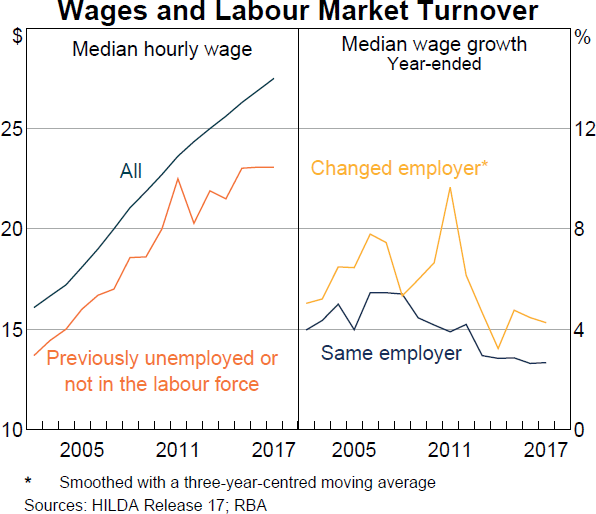
Market-based measures of inflation expectations have declined
Short-term and long-term market-based measures of inflation expectations have declined in recent months to be around 2016 levels (Graph 4.17). These declines, which have also occurred in market measures of inflation expectations for other economies, appear to be related to the recent sharp fall in oil prices.
In contrast, survey-based measures of inflation expectations for Australia are little changed. Long-term survey-based measures of inflation expectations remain around 2½ per cent.
